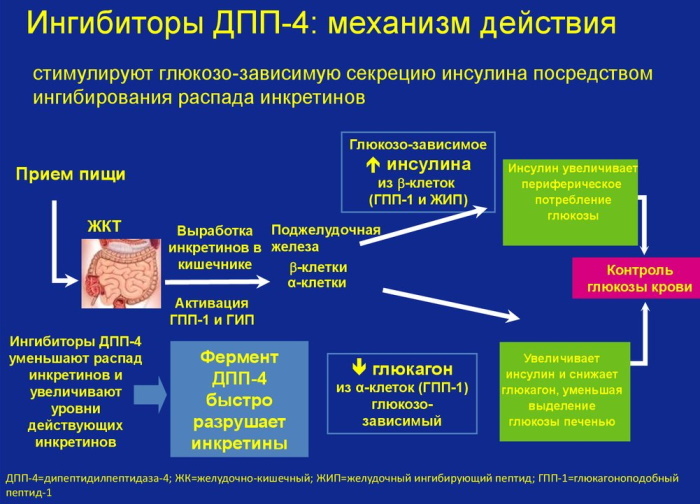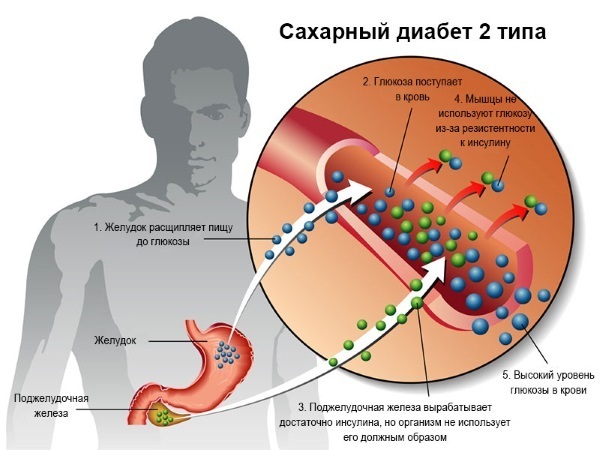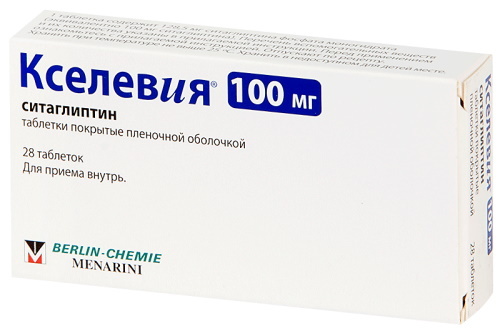Content
- Composition and form of release
- Terms of sale, prices
- Action
- Indications and contraindications for use
- Method of administration and dosage
- As monotherapy
- Combined with other remedies
- With renal failure
- With liver pathologies
- Some analogues
- Diabetes Medication Videos
Xelevia is a hypoglycemic agent that is used when diagnosing patients type 2 diabetes mellitus. Usually, the drug is used in a dosage of 100 mg, and its price differs depending on the region of distribution and the specific pharmacy. The tool is distinguished by relative safety and high efficiency, therefore, it is often used as monotherapy or as part of a complex treatment.
Composition and form of release
The pharmaceutical product is available to patients in the form of film-coated tablets. They are small in size, round, biconvex. The color of the tablets can be beige or slightly yellowish.
The tablets are placed in standard plastic plates, in each of which you can find 14 or 28 pieces.
Blisters are placed in a small cardboard box. In it you can find not only pills, but also a description, which details the nuances of use, possible contraindications and negative reactions that occur during the period of therapy. The medicinal product contains the active substance sitagliptin, which has pronounced therapeutic properties.
Film-coated tablets also have excipients:
- Magnesium stearate.
- Microcrystalline cellulose.
- Talc.
- Povidone.
- Macrogol.
- Iron oxide.
- Titanium dioxide.

Excipients do not have medicinal properties. The amount of active ingredient in 1 tablet is 100 mg.
Terms of sale, prices
Xelevia 100 mg (the price of the product depends on its quantity in the package) is expensive, since about 1400 rubles will have to be paid for the package. in different pharmacies and regions, the cost may change in one direction or another.
A medication is a prescription-only form of medicine issued by a doctor.
Action
The drug has pronounced hypoglycemic properties. Its mechanism of action is based on the ability of the active substance to block some enzymes that provoke a sudden increase in blood glucose levels. Against the background of the use of the medication, the glucose level normalizes, as well as a decrease in the likelihood of progression of the underlying disease.
With prolonged use, the drug has another effect on the body:
- Tablets reduce the risk of progression of peripheral vascular disease. In patients with type 2 diabetes mellitus, such complications often occur, especially if the rules of proper nutrition, determined by the doctor, are violated.
- There has been an improvement in the functioning of the pancreas in patients. Normally, the body promotes better food processing and produces the necessary enzymes. The development of diabetes mellitus leads to disruption of the organ.
- Reduces the production of glucose by the patient's liver, which leads to a decrease in glucose levels and prevents the development of hyperglycemic coma.
- Stimulates insulin release. In this case, the effect is noted not only in patients with diabetes mellitus, but also in patients who do not have a history of such disorders.

When taking the drug, its maximum concentration in the blood is reached after 1-4 hours, depending on the characteristics of digestion. Absorption in the small intestine occurs quickly, the component enters the bloodstream and spreads throughout the body. The bioavailability of the drug reaches 87%, which explains its high efficiency in the treatment of patients. The action of the drug lasts for 24 hours, which will allow you to take only 1 tablet per day, if you do not need to prescribe other tablets.
Xelevia 100 mg (the price of the drug is high for many patients), after processing in the body, is evacuated with the help of the kidneys. At the same time, about 80% of its amount is excreted unchanged. The rest of the remedy is evacuated with bile. The presence of kidney and gallbladder pathologies can cause changes in pharmacokinetic characteristics in a particular patient. Not more than 16% of the total amount of the active substance is excreted in a modified form.
Despite the slowdown in excretion, the accumulation of the drug in the blood does not occur, which reduces the likelihood of an overdose with prolonged use. Each patient showed absorption and assimilation may differ, which does not affect the therapeutic effect. Food intake also does not slow down absorption and the onset of hypoglycemic action.
Prolonged use does not lead to the development of tolerance to the active substance of the drug. That is why patients can take it as monotherapy for a long period of time. The combination of the drug with other means also does not lead to the development of the body's resistance to the active ingredient of the composition.
Indications and contraindications for use
Xelevia at a dosage of 100 mg is often prescribed to patients, despite the fact that the price of the drug is high.
The main indications for the use of the medication:
- Diagnosing the initial stage of type 2 diabetes mellitus. In this case, the drug is used as monotherapy to maintain glucose levels.

- Temporary treatment of patients who, against the background of a disease, have an increase in glucose levels. Often, with mild cerebral circulation disorders, hypoglycemia is manifested in patients. After recovery, the condition is normalized, and the reception can be stopped.
- Adjunctive therapy for severe diabetes mellitus. The medicine can be combined with other medicines, which can improve the effectiveness of treatment.
As an auxiliary treatment, the drug is not used so often, as the likelihood of complications increases when several medications are combined.
The medicine has contraindications that must be taken into account before starting use. For example, a medication is not prescribed in case of intolerance to the components of the composition or a tendency to such manifestations. Even in the case when the patient previously had negative reactions to drugs from this group, you should not use the medicine on your own.
The official instruction also describes other contraindications:
- Pregnancy and breastfeeding period. To date, there is no data on the safety of the drug for pregnant and lactating women. Usually, use for such patients is not required, but if necessary, other, safer, tablets are selected.
- Diagnosing type 1 diabetes mellitus. The medicine for this form of pathology does not help to improve the condition, but it can aggravate the course. Only sometimes pills can be combined with insulin therapy, but in patients with type 2 pathology.
- Ketoacidosis of diabetic origin, in which the work of not only the kidneys, but also the entire urinary system is disrupted.
- Hepatic failure in acute form, in which the work of the organ is disrupted.
- The patient's age is up to 18 years. Children and adolescents do not need medication as they do not have type 2 diabetes.
- Internal bleeding that occurs against the background of damage to the mucous membranes of the intestines and stomach.
- A state of shock in which there is a critical decrease in blood pressure.
- Diagnosing a hypoglycemic coma in which glucose levels suddenly and significantly drop.

Xelevia 100 mg
With caution, the drug is prescribed to patients with renal failure, acute pancreatitis, decompensated heart failure. In each case, the doctor makes a decision on the prescription of the medicine based on the examination data and the patient's interview.
Xelevia 100 mg (the price of the drug is not considered an indicator of its effectiveness for each patient) can provoke negative reactions affecting the work of internal organs and systems.
| Damage area | Most common adverse reactions |
| Nervous system | On the part of the nervous system, disorders are manifested in the form of sleep disturbances, headaches. It is important to remember that the drug may cause temporary dizziness after taking it, which is not considered a reason to stop treatment. |
| Digestive tract | Nausea and vomiting are often observed when taking the drug. Many people note upset stools and intense thirst, impaired digestion. |
| Vessels and heart | Arrhythmia and bradycardia can disturb patients with a history of chronic heart disease. Some people talk about fluctuations in blood pressure. |
| urinary system | An increased risk of urinary tract infections is present with the drug. Many patients report increased urination. |
| Skin and mucous membranes | Allergy to the drug is less common. Sometimes patients notice a rash on the skin that spreads to large areas, swelling of the mucous membranes of the mouth, nasal passages and eyes. |
Overdose rarely develops during therapy. At the same time, the condition worsens, accompanying deviations appear. Some negative reactions do not require the appointment of medications to normalize the condition, disappear on their own after stopping treatment or continuing to take the drug.
If de symptoms worsen, and the effectiveness of the drug decreases, it is better to consult a doctor who will determine the appropriateness of prescribing drugs that eliminate the manifestations. It is not recommended to ignore the reactions or take any medication on your own.
Method of administration and dosage
The tablet medicine is intended only for oral administration in the dosage prescribed by the doctor. Usually, the regimen is standard and does not imply a change for various diseases. Only if the patient has kidney and heart pathologies is it possible to change the dose, but this is determined by the doctor based on the examination data.
As monotherapy
As the only method of treatment, the drug is taken once a day at a dosage of 100 mg, that is, 1 tablet. It is recommended to take the drug at about the same time of the day to ensure a uniform effect of the drug on the patient's body.
The duration of therapeutic use is determined individually, depending on the patient's condition. Often, the medicine is taken on an ongoing basis, sometimes a course use is required for several weeks. It is important to combine taking a pill with drinking plenty of fluids.
Reception of a double dosage in case of missing 1 tablet is not allowed. This can provoke severe hypoglycemia, which threatens the patient's life. If the patient missed the appointment, but he does not develop negative reactions, it is worth taking the next pill at the usual time.
Combined with other remedies
Xelevia 100 mg, the price of which differs in different regions, is often prescribed in combination with other medicines to increase the effectiveness of therapy. Usually, dose adjustment is not required, that is, the patient takes 1 tablet per day at his usual time.
Other means are taken as prescribed by the doctor, who determines the optimal time, taking into account the fact that the patient is using a hypoglycemic medication. The duration of admission as part of a combination therapy is determined individually.
With renal failure
No dosage adjustment is required when mild and moderate pathology is detected in patients. It is necessary to take 1 tablet of the drug per day for the period specified by the doctor.
If the patient suffers from severe renal failure, a dose reduction of 50 mg is possible. There is no line on the tablet along which you can evenly divide it. That is why this method is rarely used.
It is forbidden to independently adjust the dosage or stop taking it without a doctor's prescription. It is especially important to follow some nutritional rules to consolidate the effect of the use of tablets.
With liver pathologies
If the patient suffers from any mild to moderate liver disease, dosage adjustment is not required. In most cases, the drug is taken according to the standard scheme, that is, once a day in the amount of 1 tablet.
The lack of a therapeutic effect or the appearance of complications from the liver is considered a reason for refusing to use the medicine and seeking medical attention. If an appointment is required in combination with drugs to restore liver cells, it is important to follow all the doctor's recommendations, as well as the diet. Determined for each patient individually.
Some analogues
The original remedy may not always be used, so doctors select the most effective substitute for the patient with similar properties. Analogs do not always have the same composition, but their mechanism of action is similar.
Effective substitutes:
- Onglisa - a drug in tablet form, which contains the substance saxagliptin, which has pronounced hypoglycemic properties. The mechanism of action of the drug is the same, despite the different ingredient in the composition. The medication is indicated for the diagnosis of type 2 diabetes mellitus, both as an independent therapy and in combination with other means. The drug is considered relatively safe and more convenient to use, since the tablets are available in dosages of 2.5 and 5 mg. Each patient, if necessary, can choose a suitable option for himself.
- Januvia - an analogue of the product in terms of composition and mechanism of action. The drug has the same active ingredient, helps control blood glucose levels, prevents the development of hyperglycemic coma and peripheral vascular pathologies. The analogue application scheme is no different. Like the original, the analogue is available in tablet form with a dosage of 100 mg, which does not allow, if necessary, to properly divide the tablet into 2 parts. The cost of an analogue is slightly higher.
- Trajenta contains linagliptin in the composition, but the mechanism of action of the drug does not differ. When the tablet gets inside, it dissolves and the active component penetrates into the patient's blood. The substance blocks some enzymes and stimulates the production of insulin, which leads to a decrease in glucose levels in patients with type 2 diabetes. The drug is taken according to the scheme, and the dosage of the substance per 1 tablet is 5 mg. No dose adjustment is usually required when using the medication.
- Galvus - a tablet medication based on vildagliptin. The tool belongs to hypoglycemic drugs, intended for the treatment of patients who suffer from different stages of type 2 diabetes mellitus. The mechanism of the analogue's therapeutic effect does not differ from the original. The tablets are taken on an ongoing basis or in courses, they can be included in the course of the main treatment or used as monotherapy. As with the appointment of other drugs, a preliminary visit to the doctor is required.
Drug substitutes have the same mechanism of action, despite the presence of other active ingredients in the composition. Patients are not allowed to independently change the dosage, duration of the treatment course or other features of therapy. If complications develop when using an analogue, you should immediately consult a doctor. Some substitutes are more likely to provoke negative reactions.
Xelevia is an effective hypoglycemic medication for the treatment of patients with type 2 diabetes. The drug in a dosage of 100 mg can significantly improve the condition, reduce the likelihood of progression of symptoms and the development of complications in the form of hyperglycemic coma. The price of the drug is high, but it is justified by its effectiveness and relative safety, provided it is used correctly.
Diabetes Medication Videos
The latest drugs for type 2 diabetes:



